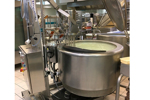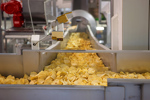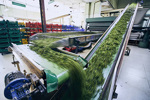FOOD BLENDING CASE STUDIES
-
National Fast-Food Chain Supplier Improves Efficiency With Mixer Selection
After trial periods with mixers, this food manufacturer has bought several mixers over the past 10 years to help improve the quality and mixing times of their broths, dressings, salsas, and cheese sauces.
-
Hospital Saves Money By Mixing And Producing Soups In House
By making the soups in-house, costs of purchasing from a specialist supplier have been eliminated and the mixers will pay for themselves in a short time through the savings made.
-
Recycling Frying Oil In The Snack Industry
A company reduced the amount of vegetable oil waste they were producing in their potato chips (crisp) batch frying process by prolonging the usable life of the oil.
-
Jelly Manufacturer Cuts 20% Of Pectin From Formulation With Mixer Solution
A jelly and marmalade producer has been able to reduce the amount of pectin in their formulation by 20% and reduce their process times and waste by replacing their agitators with mixers.
-
Food Service Company Uses Mixer And Homogenizer Combination To Avoid Equipment Clogging
A company replaces high-pressure homogenizer with an in-line mixer as a final, single-pass before pasteurization to avoid lumps and clogging of the equipment.
-
Biscuit Manufacturer Improves Powder Incorporation
This manufacturer found a solution for incorporating whey powder and egg powder into water correctly while also correcting aeration and foaming issues.
FOOD BLENDING WHITE PAPERS & ARTICLES
-
Best Practices For Conducting Virtual FAT's In Food Manufacturing
When the COVID-19 pandemic hit, it became critical that manufacturing plants remain open and operating to provide essential items such as food, beverage, sanitation supplies and more to consumers. New practices were put into place to ensure the safety of all and maintain efficient, effective operations. A critical aspect of keeping up with consumer demand has been the testing and acceptance of new equipment. With consumer packaged goods (CPG) companies reluctant to bring suppliers into their facilities and service technicians limited in their ability to travel due to COVID-19 protocol, the industry has had to get creative to complete the process.
-
Article: The Science Of Mixing Food Powders & Liquids This article explains the technologies and processes involved in product mixing of solids and liquids. By Scott Jones, Marketing Manager, Marion Mixers, Inc.
-
Contamination Control In Food Processing Equipment
Here, we highlight the issues processors experience in preventing contamination and how engineering for contamination control in food processing equipment can be a solution.
-
Mixing Equipment And Applications In The Food Industry
We discuss traditional and new specialty mixing technologies for food manufacturing and present sample applications of processing challenges and the corresponding mixing technologies to resolve them.
FOOD BLENDING NEWS
-
New SanStar Mixers From SPX Are Designed For Demanding Sanitary Applications12/9/2014
PX introduces the new SanStar SSi (Stainless Steel inline) sanitary mixer from its Lightnin brand.
ABOUT FOOD BLENDING
Industrial food blending usually refers to the process of mixing two distinct solids or mixing of bulk solids with small ratios of liquids. Blending and mixing are interchangeable terms. However, blending is generally more gentle than mixing, which is why it’s technically different. The outcome of blending is to take two or more pure elements and combine them into a new product where samples of it will contain the same ratio of the elements that were combined to be blended.
Examples of products created from mixing solids in food manufacturing include: cake mixes, coffee, tea, beverage powders, ice-cream mixes, yogurts, spices, flours, trail mixes, and cereals.
Examples of or products created from mixing solids with liquids in food manufacturing include: confectionary, pasta, ready-to-eat cereals, pet foods, and dairy products.
Blending equipment is offered in various styles. The style that your food-making operation needs will be based on many different factors, such as, but not limited to: what products are being blended, efficiency, batch size, the facility’s available manufacturing space, preciseness of the blend, energy costs, discharging options, cleaning, and sanitation options.
The most-common styles of blending equipment are:
- Ribbon Benders — are the most-popular blenders. They use helical ribbons, accommodate larger batch sizes, are very versatile, and cost efficient.
- Vertical Blenders — are cone shaped and designed for vacuum operations. These blenders are easy to clean, are gentler than horizontal blenders, and have virtually 100 percent discharge.
- Tumble Blenders — are double-cone shaped and rotate on a horizontal axis. These blenders are generally used for precise blends and thorough blending of powders.
- Paddle Blenders — These blenders use multiple paddles as agitators and accommodate larger batch sizes. They also have very low shear and generate very minimal heat.
After choosing the style of industrial food blender that will suit your company’s food-processing requirements, it will be equally important to make sure the ribbons, paddles, rods, and shafts are matched to the physical properties of the elements being blended. This is imperative to ensuring better efficiency and reducing maintenance downtime.














